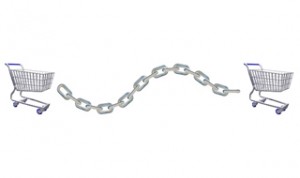
So how do you get quality inbound links for your e-commerce store? Follow these 6 easy steps.
1. Engage Your Community. Actively engage your community and ensure that you have accurate, relevant, quality information spread throughout your site. For instance, if you are selling pet products, you should have a flickr account setup that invites your customers to post pictures of their pets with your products. You need to make sure that your flickr account is prominently displayed on your site and that you are actively inviting your customers to post pictures through the use of follow up email campaigns.
2. Utilize Social Media. Your store presence should be prominent on every social media outfit relevant to your industry. You need to not only be on flickr, you need to also be on facebook, twitter, linkedin and every website and community that is relevant to your industry. You need to know what your customers are saying about you, and the best way to do this is to get involved in their conversations. Negative feedback is not terrible, it is a great opportunity to fine-tune your store. If one customer is having a problem, there are probably others having that same problem. You want to fix and eliminate as many customer problems as you can. One of the best ways to let your customers know that you are serious about doing this is tell them! Another great way to engage in your social media community is with special promotions and advertisements personalized for each social media outlet. Start a twitter account and offer 10% off a promotional product to the 100th person who tweets "I Love Shopping At [Your Store Name]".
3. Blog it! Write and actively keep up a blog regarding your store. Try to write daily if possible, but at least weekly. Keeping up with a blog can be time consuming, especially when you are running a full scale e-commerce operation, but a blog is an important function to build quality inbound links. Ask other employees and co-workers to help you by writing about their specific expertise. Make sure that you keep your content brief and easy to understand so many people can spread your message.
4. Write Articles. Write and submit articles about your company to industry news sites. Make sure that the first article you submit is better than most of your other articles and is also relevant and “newsworthy” before you submit. Remember to personalize your request for every site and be sure to tell the author or owner of the site why your article is relevant and worthy of their attention. You will only have one chance at a first impression, make it a good one!
5. Directories – Use ‘em! Submit your online store to online directories such as DMOZ.org, Yahoo Directory, Business.com, ect. There are thousands of directories to submit to, ranging from free submission to yearly subscription costs. An important first step before you go submission crazy is to do your research and be patient. Compile a thorough list of directories before you start submitting, and then make a daily calendar reminder to submit to a directory daily or every other day. You want to be careful not to submit your site to too many directories at one time as this could raise red flags and make your site suspicious of link farming. Setting a daily calendar reminder like I mentioned is an easy way to start your directory submission campaign.
6. Become A Savvy Reviewer and Commenter. A great way to get others to visit your store from other sites is to actively review products or services you sell that others may be selling. For instance, if you sell comic books, you should be a savvy commenter on all other sites that sell comic books. Another very important element is to comment on popular articles relevant to your industry. A good comment or review may attract the attention of the author and the readers of that author. The more comments you make, the more the author and the readers will be enticed to visit your site. Be careful when writing your comments and reviews to not come across as an advertisement for your site. This is very unpopular and will gain you little traffic. Be sure you are writing relevant comments and leaving your website address as your signature or in the box provided to leave your website if specified by that sites administrator. Although the link may have a “no-follow” (doesn’t give your site credit for a link back), your site will still be in front of the readers and authors eyes. A savvy comment or review will garner a link to your site and will help improve your search ranking with every click. Read More









